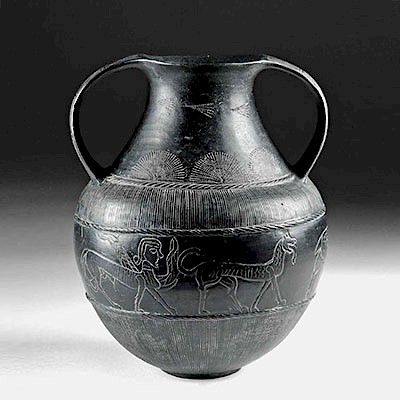Fine Paracas Bone & Turquoise Spatula - Eagle & Human
Lot 159a
About Seller
Artemis Fine Arts
686 S Taylor Ave, Ste 106
Louisville, CO 80027
United States
Selling antiquities, ancient and ethnographic art online since 1993, Artemis Gallery specializes in Classical Antiquities (Egyptian, Greek, Roman, Near Eastern), Asian, Pre-Columbian, African / Tribal / Oceanographic art. Our extensive inventory includes pottery, stone, metal, wood, glass and textil...Read more
Estimate:
$1,500 - $2,000
Absentee vs Live bid
Two ways to bid:
- Leave a max absentee bid and the platform will bid on your behalf up to your maximum bid during the live auction.
- Bid live during the auction and your bids will be submitted real-time to the auctioneer.
Bid Increments
| Price | Bid Increment |
|---|---|
| $0 | $25 |
| $300 | $50 |
| $1,000 | $100 |
| $2,000 | $250 |
| $5,000 | $500 |
| $10,000 | $1,000 |
| $20,000 | $2,500 |
| $50,000 | $5,000 |
| $100,000 | $10,000 |
| $200,000 | $20,000 |
About Auction
By Artemis Fine Arts
Mar 21, 2019
Set Reminder
2019-03-21 10:00:00
2019-03-21 10:00:00
America/New_York
Bidsquare
Bidsquare : Fine Ancient | Asian | Ethnographic Art
https://www.bidsquare.com/auctions/artemis-gallery/fine-ancient-asian-ethnographic-art-3967
Featuring classical antiquities, ancient and ethnographic art from cultures encompassing the globe, plus fine art. Egyptian, Greek, Roman, Etruscan, Near Eastern, Asian, Pre-Columbian, Native American, African / Tribal, Oceanic, Spanish Colonial, Russian, Fine Art, so much more! Artemis Fine Arts info@artemisfinearts.com
Featuring classical antiquities, ancient and ethnographic art from cultures encompassing the globe, plus fine art. Egyptian, Greek, Roman, Etruscan, Near Eastern, Asian, Pre-Columbian, Native American, African / Tribal, Oceanic, Spanish Colonial, Russian, Fine Art, so much more! Artemis Fine Arts info@artemisfinearts.com
- Lot Description
Pre-Columbian, Central Coast Peru, Paracas, ca. 500 to 100 BCE. A large spatula carved from a human leg bone used for extracting lime powder from a container as part of an elaborate shamanic ritual of ingesting hallucinogenic drugs like coca. The long bone has a gently curving body with most of its length hollowed out to form a trough. Perched at one end is a stylized eagle with wings folded against the incised lattice-pattern body and eyes inlaid with petite turquoise beads. Beneath the bird is an abstract anthropomorphic face - perhaps a trophy head - which laterally protrudes from the shoulder of the trough, its nose flush with the cheeks and mouth, and similar inlaid turquoise beads comprising the eyes and ornamentation beneath the top of the trough. Size: 11" L (27.9 cm); 6.3" H (16 cm) on included custom stand.
The depiction of avian figures in Paracas art is a common yet symbolically-significant motif which is varied, rich, and reflects the many birds native to their homeland on the central and southern coast lines of Peru. Paracas artists emphasized the more fearsome aspects of all the animals they depicted, here with a prominent aquiline bead taking precedence. Birds often accompany trophy head art, and there are also "bird impersonators" - human figures with avian characteristics - who also appear on Paracas textiles; this suggests a tradition of performance where humans dressed as birds. Hallucinogenic drugs like coca were often used by shamans to enter a spiritual state where they could become one with animal life.
Provenance: private Hawaii, USA collection; ex-private Hans Juergen Westermann collection, Germany
All items legal to buy/sell under U.S. Statute covering cultural patrimony Code 2600, CHAPTER 14, and are guaranteed to be as described or your money back.
A Certificate of Authenticity will accompany all winning bids.
We ship worldwide and handle all shipping in-house for your convenience.
#144589Small nicks to end of trough, trophy head, and eagle, with expected ossification and darkening commensurate with age, and minor softening to some finer details. Light earthen deposits and nice patina throughout.Condition
- Shipping Info
-
All shipping is handled in-house for your convenience. Your invoice from Artemis Gallery will include shipping calculation instructions. If in doubt, please inquire BEFORE bidding for estimated shipping costs for individual items.
-
- Buyer's Premium



 EUR
EUR CAD
CAD AUD
AUD GBP
GBP MXN
MXN HKD
HKD CNY
CNY MYR
MYR SEK
SEK SGD
SGD CHF
CHF THB
THB














